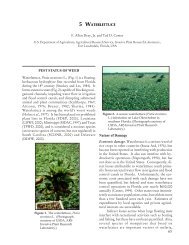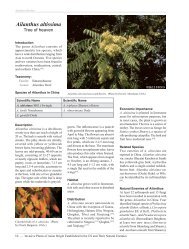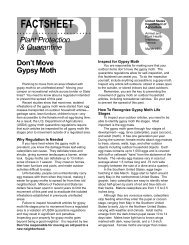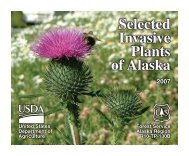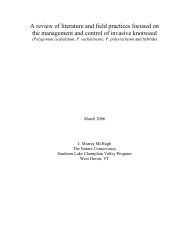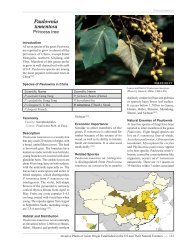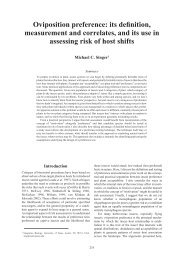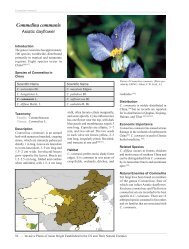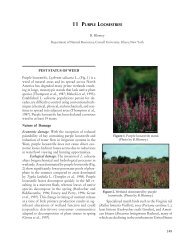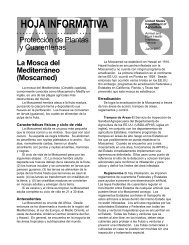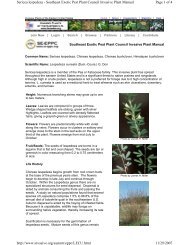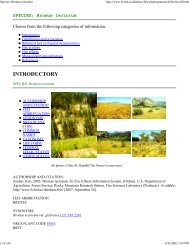A Guide to the Control and Management of Invasive Phragmites [PDF]
A Guide to the Control and Management of Invasive Phragmites [PDF]
A Guide to the Control and Management of Invasive Phragmites [PDF]
You also want an ePaper? Increase the reach of your titles
YUMPU automatically turns print PDFs into web optimized ePapers that Google loves.
underst<strong>and</strong>ing phragmites<br />
control methods<br />
recommended management strategies<br />
fur<strong>the</strong>r information<br />
part 1<br />
part 2<br />
part 3<br />
part 4<br />
19<br />
left: Using a weed whip <strong>to</strong> mechanically<br />
treat a small st<strong>and</strong> <strong>of</strong> phragmites;<br />
Nayanquing Point State Wildlife Area, MI.<br />
D. Avers<br />
-Mechanical Treatment<strong>to</strong><br />
reach <strong>the</strong> soil surface. This ensures<br />
that <strong>the</strong> native seed bank will have an<br />
advantage during <strong>the</strong> subsequent growing<br />
season. Use <strong>of</strong> a flail-type mower can<br />
eliminate <strong>the</strong> need for thatch removal,<br />
since it will destroy most plant parts adequately.<br />
Under limited circumstances, for example,<br />
when isolated plants or low density<br />
st<strong>and</strong>s <strong>of</strong> phragmites exist <strong>and</strong> herbicide<br />
treatment is not feasible, mechanical<br />
treatments alone may be used <strong>to</strong> reduce<br />
phragmites <strong>and</strong> encourage native plants.<br />
In <strong>the</strong>se situations, cutting individual<br />
plants or mowing small areas <strong>of</strong> phragmites<br />
once during late summer/fall<br />
(September <strong>to</strong> first killing frost) appears<br />
<strong>to</strong> have <strong>the</strong> best results because it eliminates<br />
<strong>the</strong> surface biomass <strong>of</strong> <strong>the</strong> plant<br />
when it is using most <strong>of</strong> its energy for<br />
flower <strong>and</strong> seed production. Cutting/<br />
mowing in late summer also eliminates<br />
potential disruption <strong>to</strong> <strong>the</strong> breeding <strong>and</strong><br />
nesting seasons for most birds. If a<br />
mower is used instead <strong>of</strong> h<strong>and</strong>held <strong>to</strong>ols,<br />
<strong>the</strong>n <strong>the</strong> mower deck should be set <strong>to</strong> a<br />
mowing height greater than 4 inches <strong>to</strong><br />
minimize impact on small animals <strong>and</strong><br />
native plants. Mechanical treatments are<br />
not intended <strong>to</strong> create <strong>the</strong> appearance <strong>of</strong><br />
a manicured lawn, but <strong>to</strong> allow reestablishment<br />
<strong>of</strong> native wetl<strong>and</strong> vegetation.<br />
Cutting/mowing should occur only in<br />
those areas where phragmites is present.<br />
Mechanical methods must be used carefully<br />
<strong>to</strong> avoid stimulating growth <strong>of</strong><br />
phragmites. Mowing alone leaves <strong>the</strong><br />
plants’ rhizomes behind. Regeneration<br />
from those rhizomes may cause an<br />
increase in st<strong>and</strong> density. Improper use<br />
<strong>of</strong> mechanical methods, such as cutting<br />
during <strong>the</strong> wrong time <strong>of</strong> year, cutting<br />
<strong>to</strong>o frequently, <strong>to</strong>o short, or where native<br />
plants are present, can disrupt wildlife<br />
<strong>and</strong> destroy existing native plants. Disking<br />
soil is not recommended as a mechanical<br />
control method for phragmites, since it<br />
results in <strong>the</strong> spread <strong>of</strong> rhizomes <strong>and</strong> <strong>the</strong><br />
production <strong>of</strong> new plants. Equipment<br />
used <strong>to</strong> manage phragmites must be<br />
cleaned properly <strong>of</strong> all debris before it is<br />
removed from <strong>the</strong> treatment site <strong>to</strong> prevent<br />
<strong>the</strong> unintended spread <strong>of</strong> seeds or<br />
rhizomes <strong>to</strong> o<strong>the</strong>r areas.


![A Guide to the Control and Management of Invasive Phragmites [PDF]](https://img.yumpu.com/27321025/24/500x640/a-guide-to-the-control-and-management-of-invasive-phragmites-pdf.jpg)

